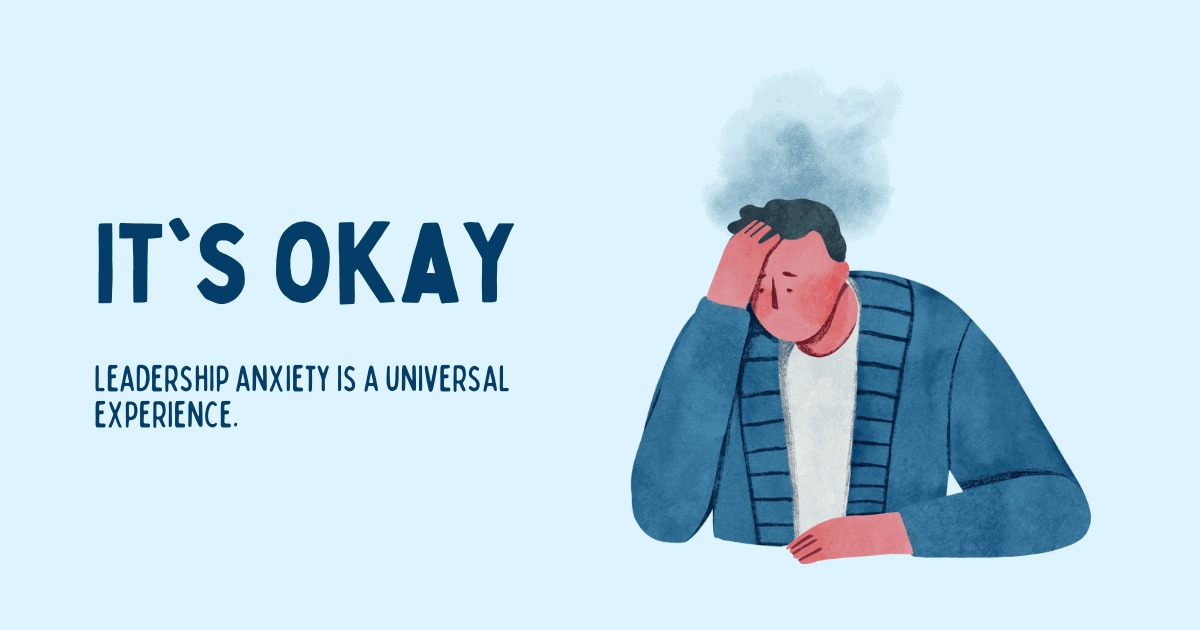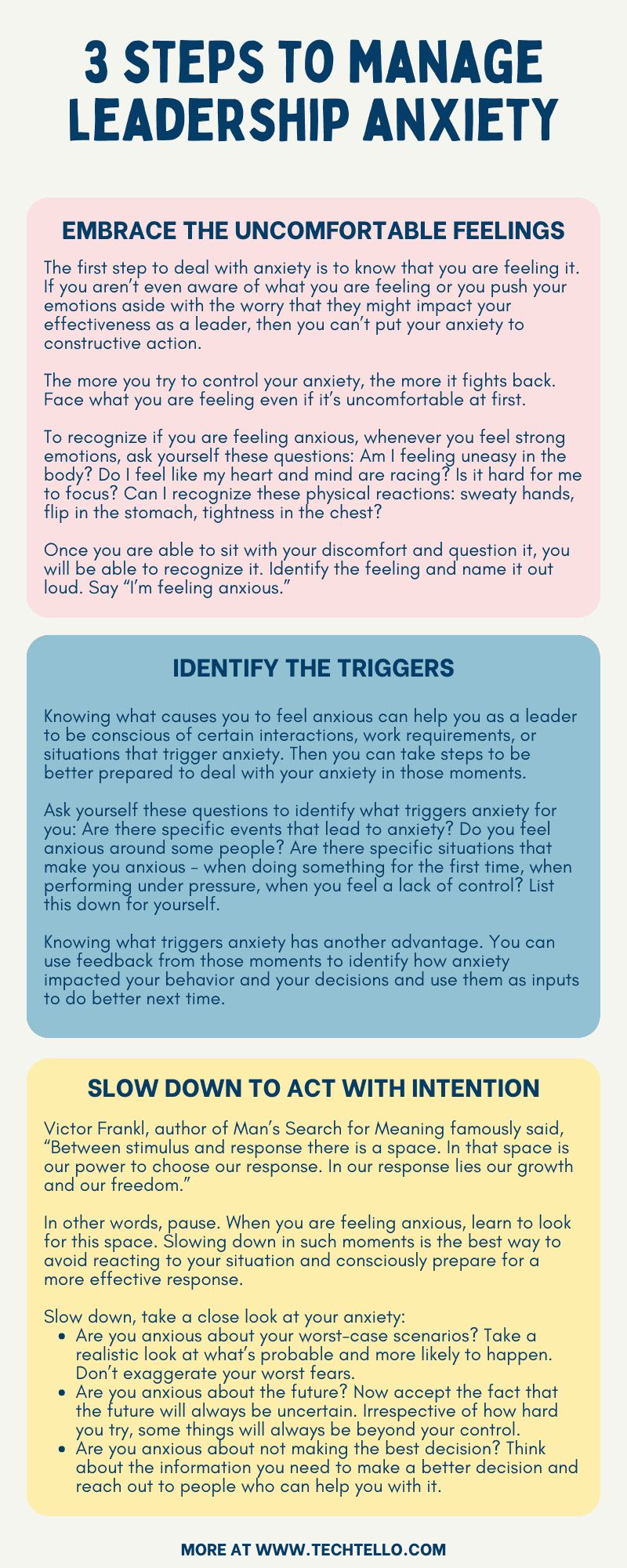Leadership Anxiety: How to Lead When You Feel It

All leaders throughout their leadership journey feel intense emotion. While some big decisions like organization restructure, negotiations, acquisitions and mergers can be a source of anxiety, oftentimes it’s the small day-to-day things like a looming deadline, presentation, or a decision meeting that can be a source of stress and anxiety.
There can be many reasons for feeling this way: You may not feel in control of your situation. Things may not work out the way you expected. You are unsure of your decision. You are scared of how the future will unfold. You worry about letting your team down. You fear that you are not doing enough and need to be doing more.
Anxiety manifests in different people in different ways.
Some anxiety can be rational and helpful and lead you to take constructive action when the situation demands, like proactively planning a future strategy for your organization, looking for creative solutions to existing problems, or enabling your team to work more effectively and productively. However, left unchecked, it can often lead to destructive patterns of behavior.
When you are full of anxious energy, you may find it hard to sit still and may reach out to your team with irrational demands. While making a decision, anxiety can impair your judgment making you ignore valid opinions, jump to conclusions and make faulty assumptions. When working on an important task, anxiety can distract you, preventing you from focusing on the task at hand and leave you feeling tired without accomplishing much. In some situations, anxiety can even freeze you, preventing you from taking action or making important decisions. You may overthink your situation and let those thoughts paralyze you.
“Anxiety is an emotional state characterized by feelings of worry, nervousness, and unease.” ― Alice Boyes in The Anxiety Toolkit.
Anxiety that stems from feelings of self-doubt and imposter syndrome are a natural part of being human. It is what can inspire you to question your choices, confront your own feelings and engage proactively with the desire to do better. The problem occurs when you let your leadership anxiety prevent you from seeing the reality of your situation. When you are so caught up in your own anxiety that it fogs your ability to think and see clearly.
As a leader, things won’t always go as expected. You will face setbacks. You will be required to see through tough times. Those things aren’t in your control. What’s in your control is whether you let your anxiety fuel your desire to clear the fog or you let it consume you and cripple you and your team.
Should you share your anxieties as a leader?
The question that I get asked most often is this: “How can I tell my team that I am scared? Isn’t it my job as a leader to project confidence?”
And I tell them this. The most unwanted consequence of leadership anxiety when left unchecked is passing on that anxiety to your teams. The idea is not to be inauthentic in your feelings, but to be careful about what you are passing to your teams without creating a sense of fear in them. How can you tell the truth without leaving them feeling hopeless? How do you express your emotions in a way that creates excitement and not feelings of desperation?
Express your vulnerability as a strength and not a weakness to be avoided. When you show vulnerability, you aren’t conveying the message that you are incompetent or that you don’t know what you are doing. Rather, you come across as a highly self-aware person who’s willing to accept the reality of their situation. There’s a fine balance between being vulnerable and saying things that make others lose confidence in your competence.
Show your teams it’s ok to feel this way at times. But it’s not ok to let these feelings bring them down. Focus your message on what can be controlled and not waste time and energy on things that are beyond your control.
As a leader, demonstrate confident humility – humility to acknowledge the state of things as they are and confidence in your ability to set things right. You don’t want to burden your people with details about your insecurities. At the same time, you don’t want to mislead them by painting a rosy picture either.
Saying “I am scared about this decision,” only conveys that you care about getting it right.
Saying “I know some of you might be feeling anxious about the merger. I am feeling it too,” makes others connect to you personally and emotionally.
Many leaders believe that anxiety in a leader is a bad thing and their people will trust them more if they focus on showcasing their strengths and competence while locking up their emotions and keeping their fears away. But they forget this – If you are feeling anxious, it may not reflect in your words, but it will definitely show up in your body language. People can see when you are being inauthentic and they can’t trust you if what you say differs from how you behave. Daniel Goleman, the renowned psychologist and author of Emotional Intelligence, calls this “neural Wi-Fi,” in which humans can pick up on others’ unspoken feelings and detect their emotions through their actions.
Nelson Mandela famously said “Courage is not the absence of fear, but triumph over it. The brave man is not the one who does not feel afraid, but he who conquers that fear.” Great leaders act despite feeling anxious. They don’t hide their fears. They don’t let their fears pull them down.
3 steps to managing leadership anxiety
1. Embrace the uncomfortable feelings
The first step to deal with anxiety is to know that you are feeling it. If you aren’t even aware of what you are feeling or you push your emotions aside with the worry that they might impact your effectiveness as a leader, then you can’t put your anxiety to constructive action.
Remember this: the more you try to control your anxiety, the more it fights back. Face what you are feeling even if it’s uncomfortable at first.
To recognize if you are feeling anxious, whenever you feel strong emotions, ask yourself these questions:
- Am I feeling uneasy in the body?
- Do I feel like my heart and mind are racing?
- Is it hard for me to focus?
- Can I recognize these physical reactions: sweaty hands, flip in the stomach, tightness in the chest?
Once you are able to sit with your discomfort and question it, you will be able to recognize it. Identify the feeling and name it out loud. Say “I’m feeling anxious.”
Checked: Labeling your emotions as anxiety. The next step is to identify what triggers it.
Self-Compassion Workbook
Cultivate kindness and strength in the face of difficulty and foster a new, more gentle and loving perspective on your struggles.
2. Identify the triggers
Knowing what causes you to feel anxious can help you as a leader to be conscious of certain interactions, work requirements, or situations that trigger anxiety. Then you can take steps to be better prepared to deal with your anxiety in those moments.
Let’s say doing an all-hands meeting with a large group of people makes you anxious. You worry about your public speaking skills and that makes you highly self-conscious and you falter more. Knowing this, you can put a plan in place to practice your public speaking skills prior to the meeting. You can use the feedback and advice from your trusted sources to improve your speech or hire a coach who can help you with it.
Ask yourself these questions to identify what triggers anxiety for you:
- Are there specific events that lead to anxiety?
- Do you feel anxious around some people?
- Are there specific situations that make you anxious – when doing something for the first time, when you are not sure of your decision, when performing under pressure, when things don’t turn out the way you expected, when you feel a lack of control? List this down for yourself.
Knowing what triggers anxiety has another advantage. You can use feedback from those moments to identify how anxiety impacted your behavior and your decisions and use them as inputs to do better next time. Look back to some of the past events when you felt anxious and ask yourself:
- How did I respond to anxiety at that moment?
- Were my actions helpful or unhelpful?
- What can I do better next time?
The last question is the most important one because it instantly switches your mind from problem mode to solutioning mode.
Checked: Identifying what triggers it. The next step is to take conscious action.
3. Slow down to act with intention
Victor Frankl, author of Man’s Search for Meaning famously said, “Between stimulus and response there is a space. In that space is our power to choose our response. In our response lies our growth and our freedom.”
In other words, pause. When you are feeling anxious, learn to look for this space. Slowing down in such moments is the best way to avoid reacting to your situation and consciously prepare for a more effective response.
Slow down, take a close look at your anxiety and ask yourself these questions:
- Are you anxious about your worst-case scenarios? Take a realistic look at what’s probable and more likely to happen. Don’t exaggerate your worst fears.
- Are you anxious about the future? Now accept the fact that the future will always be uncertain. Irrespective of how hard you try, some things will always be beyond your control. Acknowledge this fact. Don’t try to control everything.
- Are you anxious about not making the best decision? Think about the information you need to make a better decision and reach out to people who can help you with it.
You can feel anxious as a leader for many other reasons. All you need to do is to slow down and take a pause in those moments. You will definitely end up with a much better solution.
Summary
- Leadership anxiety is a universal experience.
- Don’t try to hide what you are feeling or push it aside to make it go away. The more you try to control your anxiety, the more it fights back.
- Left unchecked, you can pass your anxiety to your teams. Don’t let your anxiety limit what your teams can achieve.
- The first step to deal with anxiety is to acknowledge that you are feeling it. Sit with your discomfort and name it out loud. Say “I am feeling anxious.”
- The next step is to identify people, situations, and events that trigger this anxiety. Once you know what causes you to feel anxious, you can be better prepared to deal with it. Use the feedback from these moments to identify how anxiety impacts your behavior and decisions to do better next time.
- Finally, when you are feeling anxious, don’t rush to action. Don’t try to fix whatever’s causing you anxiety. Rather slow down. Pause to act with intention.


































